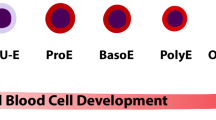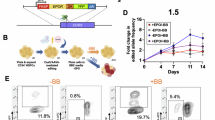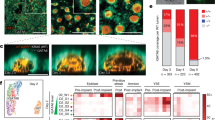Abstract
RESEARCH in development and in cancer are two of the most hotly pursued areas of modern biology. Answers will come from many directions, but red blood cell formation (erythro-poiesis) is an excellent and easily accessible model system for studies in development and cancer. In particular, erythro-poiesis in embryos, in vivo and in vitro, allows us to look at the mechanism of determination and of differentiation of cells. Such studies also have an obvious relation to an understanding of proliferative and of other diseases of the erythropoietic system, particularly in man. The purpose of this note is to point out certain strikingly similar features of erythropoiesis in the embryos of man, mouse and chicken and in the metamorphosing larva of the bullfrog, features which might well be more widespread among animals.
This is a preview of subscription content, access via your institution
Access options
Subscribe to this journal
Receive 51 print issues and online access
$199.00 per year
only $3.90 per issue
Buy this article
- Purchase on SpringerLink
- Instant access to full article PDF
Prices may be subject to local taxes which are calculated during checkout
Similar content being viewed by others
References
Lemez, L., Adv. Morphogen., 3, 197 (1964).
Wilt, F. H., Adv. Morphogen., 6, 89 (1967).
Miura, Y., and Wilt, F. H., Develop. Biol., 19, 201 (1969).
Romanoff, A. L., The Avian Embryo, ch. 8 (Macmillan, New York, 1960).
Reviewed in Small, J. V., thesis, Univ. London (1969).
Trelstad, R. L., Hay, E. D., and Revel, J. P., Develop. Biol., 16, 78 (1967).
Hay, E. D., in Epithelial-Mesenchymal Interactions (edit. by Fleischmaier), ch. 2 (Williams and Wilkins, Baltimore, 1968).
Rifkind, R. A., Chui, D., and Epler, H., J. Cell Biol., 40, 343 (1969).
Bank, A., Rifkind, R. A., and Marks, P. A., Regulation of Erythropoiesis (edit. by Gordon, A. S.), 1, ch. 31 (Appleton-Century-Crofts, New York, 1970).
Bruns, G. P., thesis, Massachusetts Institute of Technology (1971).
Weintraub, H., Campbell, G. L., and Holtzer, H., J. Cell Biol., 50, 652–669 (1971).
Settle, G. W., Contrib. Embryol., 35, 221 (1954).
Hagopian, H. K., and Ingram, V. M., J. Cell Biol., 51, 440 (1971).
Ingram, V. M., The Hemoglobins in Genetics and Evolution (Columbia University Press, New York, 1963).
Bertles, J. F., in Regulation of Erythropoiesis (edit. by Gordon A. S.), 1, ch. 32 (Appleton-Century-Crofts, New York, 1970).
Moss, B., and Ingram, V. M., J. Mol. Biol., 32, 481 and 493 (1971).
Maniatis, G. M., and Ingram, V. M., J. Cell Biol., 49, 372, 380 and 390 (1971).
Author information
Authors and Affiliations
Rights and permissions
About this article
Cite this article
INGRAM, V. Embryonic Red Blood Cell Formation. Nature 235, 338–339 (1972). https://doi.org/10.1038/235338a0
Received:
Revised:
Issue date:
DOI: https://doi.org/10.1038/235338a0
This article is cited by
-
An extra-erythrocyte role of haemoglobin body in chondrocyte hypoxia adaption
Nature (2023)
-
Regulation of hematopoiesis and the hematopoietic stem cell niche by Wnt signaling pathways
Cell Research (2007)
-
Hemoglobin switching in the salamanderPleurodeles waltlii
Wilhelm Roux's Archives of Developmental Biology (1982)
-
Fetal hemopoiesis
Virchows Archiv B Cell Pathology (1974)
-
Sites of Haemoglobin Synthesis in Amphibian Tadpoles
Nature New Biology (1973)



